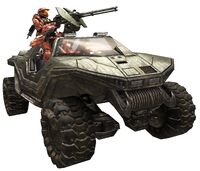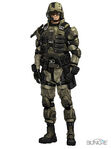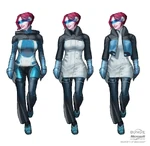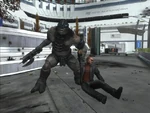| There is more information available on this subject at Human on the English Wikipedia. |
| This article does not have enough inline citations or proper citation format. You can help Halo Alpha by adding citations. |
For too many years, humanity was on the backfoot, reacting to threats rather than preventing them. The rest of the galaxy was bigger than us, stronger than us. We were mice hiding in the shadows hoping the giants would not see us. No more. Humanity is no longer on the defense. We are the giants now.
|
Humans (Latin: Homo sapiens, meaning "wise man") are a race of sentient bipeds native to the planet Earth. By the mid-26th century, Humanity had become an established spacefaring race, obtaining Tier 2 status of the Forerunner Technological Achievement system due to research and the development of weapons and armor during the Human-Covenant war.[3]
History
Early Civilization and Regression
- Main article: Prehistoric human civilization

Humans and Forerunners battling during the Human-Forerunner war.
Humanity advanced early in its history. Its technology became highly sophisticated, and it outward expanded along the Orion Arm to escape Forerunner control thousands of years before the activation of the Halo Array. Humanity once formed an alliance with the San'Shyuum and later warred against the nascent Flood. Humanity drove the Flood from the galaxy for the next several millennia, but the conflict caused a war with the Forerunners. The Forerunners won and, as punishment by the Didact (Forerunner leader) reduced humanity to a pre-technological state: he stripped them of their technology, smashed their civilizations, and exiled their remnants to Earth. Though The Librarian watched over and guarded humanity as the race scraped itself back together, The Didact used the Composer to destroy a small portion of mankind. Because of this The Librarian locked The Didact away for the safety of humanity and himself.
The Ark and reseeding
Humanity was one of many species that the Librarian indexed and preserved aboard Installation 00. After the Halo Array fired, they were returned to Earth.
Post-Array recovery
The development of human civilization as modern humans know it began ten thousand years ago with the Neolithic Revolution, during which humans learned how to systematically use plants to produce edible food-energy. The stability thereby gained enabled more permanent settlements and the development of ever more complex tools.
Innovative toolmaking and the domestication of other species provided human populations greater and greater power to expand their populations, and trade ensured the diffusion of new technologies to adjacent groups. These exploding populations formed the first genuine civilizations over 8,500 years ago in Northern Africa, Southwest Asia, Asia Minor, and elsewhere soon after. The infrastructure of civilizations continued to grow in size and complexity as innovative technologies and larger populations increased food-energy availability. Economic, political, and scientific advancement continued to quicken by automating many tasks in the Industrial Revolution. Human civilization rapidly developed during the 18th through 20th centuries, which comprised an era known as the "Industrial Revolution." The major political and economic ramifications of the rise constitutional governments and refined capitalist resource management techniques enabled such important inventions as automobiles, electrical appliances, and aircraft to enter use at unprecedented scales. Humanity's understanding of medicine and chemistry raced ahead and created anesthesia, along with plastics that could cheaply fulfill an enormous amount of material roles (with the better preservation of food being one of its greatest functions). The average human lifespan of approximately forty-five years leapt to eighty or one hundred years because of antibiotics and other medicines combined with better food production and preservation: the age-old scourges of plague and famine were nearly eradicated.
Mankind more efficiently applied previous sciences and arts, and the art of the military would prove no exception to this pattern. Armed conflicts rapidly changed from the primitive, melee-oriented wars of the past: after two massive wars within the first 50 years of the 20th century, humans invented superior firearms, automatic weapons, radar, tanks, missiles, jet engines, and ultimately the atomic bomb, which became the most powerful weapon then known and later a key component of human arsenals during the brutal war against the Covenant.
Over the next 60 years the superpower nations of the United States of America and the Union of Soviet Socialist Republics (succeeded by the Commonwealth of Independent States) competed in a period of military and cultural tension known as the "Cold War." The lethality of humanity's relatively new warfare technologies, tactics, and battlefield doctrines became more destructive and precise as each nation tried to intimidate the other. In the 1950s, the Soviet Union launched the earliest satellite and sent the first human, Yuri Gagarin, into space, officially making humans space faring (and thus at Tier 5 in the Technological Achievement Tiers). The United States successfully placed the first human, Neil Armstrong, on the Moon, and eventually surpassed the Soviet Union's space faring and military production capabilities; their doctrines would heavily influence the UNSC in later centuries.
These advancements caused the Digital Revolution, in which computing machines enabled scientific discovery and technological development to accelerate with explosive speed. As larger urban centers and tools for civilian and military uses, along with more modern economic and political systems, developed, individuals enjoyed longer, more pro-creative, and more comfortable lives, now virtually impervious to the creatures from whose midst they sprang. Thus-unchecked, the human population eventually exceeded the comfortable carrying capacity of earth by several billion and created a great desire for humans to expand off world. In 2291 the means to finally address this pressure was invented, and billions would gladly choose to emigrate to new worlds brought within reach via the Shaw-Fujikawa Translight Engine.
Additionally, the creation of the Internet in the late 20th century revolutionized communication and data processing, thereby further accelerating mankind's rate of technological progress. World politics also changed with the formation of the United Nations. The religiously neutral nature of many of these constitutional style governments, along with scientific and logical explanations for phenomena and methodology, relatively diminished the weight of ideological dogma. Religion would remain a staple of human societies insofar as advocating personal ethical codes, though unlike that of the Covenant, it was no longer primarily a mere framework to justify a large, hierarchical system of differing castes and birthrights. In the late 20th century, satellites used solar energy instead of primitive battery sources and could therefore work long enough to send and retrieve data and communications and be a method of civilian and military navigation. Although much of the technology used during this time is disregarded as "primitive" by the standards of the 26th century, they were all somehow a precursor to all of technologies utilized later by the UNSC.
Colonization
- Main article: Domus Diaspora

Phoenix-class colonial support vessels in orbit of the Outer Colony of Arcadia.
The species was able to explore the space immediately surrounding their home planet in the 20th century, as the population began to advance beyond the capacity of the planet to comfortably sustain their civilization. The subsequent conflict over resources, economics, religion and politics on Earth gave way to numerous wars. Furthermore, these tensions put great pressure on the species in the beginning of the twenty-third century, and the transnational organization that became the Unified Earth Government (UEG) engaged in more frequent space colonization and sought to represent the entire species, even though no one state ever previously ruled the entire human race. The development of Slipspace travel in 2291 helped the UEG engage in spreading the human race beyond their home solar system, relieving the serious ecological pressure on the home world.
Simultaneously, this expansion was also to usher in promising new opportunities for humanity, as some of these colonies, such as planet Reach with its bountiful titanium deposits, could offer abundant stores of raw materials that had otherwise been considerably unique and scarce on Earth. With the initial advent of interplanetary trade driving down the costs of what had once been an expensive implementation of their technology - such as the forging of space-worthy ships and naval vessels - the effects from these carefully implemented first colonization projects helped to ensure that interstellar trade, travel and communication were to be more commonplace amongst the general populace in the ensuring centuries, eventually granting humanity the capacity to expand to hundreds of worlds and establish colonies at enhanced rates.
The Great War
- Main article: Human-Covenant war

The Covenant Empire on Reach, during its fall.
The species as a whole was finally pushed into major conflict when, after several centuries of spreading throughout many star systems and inhabiting hundreds of worlds, they discovered the violent, genocidal, theocratic Covenant. As the decades-long war wore on, the human race gained the controversial reputation as a worthy adversary against the Covenant, despite the fact that they were technologically, numerically and physically inferior. Humans with the help of the SPARTANs, could hold out in ground combat and sometimes defeated the Covenant (on the rare occasion, without the aid of the SPARTANs), but in space the Covenant had virtually undisputed supremacy, thanks to their talents for re-purposing Forerunner technology, space tactics and not to mention whenever they were defeated on the ground, they would glass the planet.
Humans have been able to show great bravery when facing insurmountable odds. Some of the members of the Covenant wonder why the Hierarchs had refused to allow the humans to join them, as they had with the crucial contributions of the SPARTAN-IIs been able to hold steadfast even when outmatched in almost every way. However, despite great courage, the future seemed dark for the survival of the human race as the Covenant continued to wipe out their colonies, marching ever closer to Earth. On October 20, 2552, Earth was found. In the ensuing battles over possession of Earth, humanity suffered heavy casualties.
March 3, 2553,[4] saw the end of the Human-Covenant war as a Pyrrhic victory for humanity and their new found Sangheili allies - the majority of the Covenant Loyalist military having been defeated at Delta Halo by the Sangheilian Fleet, and the rest annihilated by the joint Elite-UNSC forces at the Ark. This victory came in time to save the human homeworld, thanks to the actions of the Arbiter and SPARTAN John-117.
Description
Anatomy and Physiology

Human blood is a red color due to the hemoglobin used to carry oxygen throughout the body.
Humans are warm-blooded mammals who give birth to live offspring, and nourish their offspring with milk. They have five fingers, one being an opposable thumb, which a few Covenant species do not have. It was a major part in helping humans dominate on Earth. Their circulatory system is closed and consists of one heart and a network of blood vessels and red blood due to the iron-based hemoglobin of humans, as well as two lungs which breathe mainly a nitrogen-oxygen-based atmosphere. Externally, they have more hair than most Covenant species. Their eyes have more pinpointed pupils allowing for good vision, and their sense of hearing can detect very low pitch sounds. However, their sense of smell is fairly poor. They are omnivorous, meaning that they will eat both meats and plants, as well as consume high calcium foods, such as the milk of other animals, in great quantities. They have a more developed bone structure for protecting organs.
Humans are lean and possess relatively little muscle tissue. The relatively low power output of the human anatomy translates into a low upkeep for their sustained bodily functions. With a metabolism well-suited for the moderation of internal body temperature, less recovery time is required from physical exertion compared to other species. Though potential prey would easily out pace them at first, by pure stamina alone, early humans were able to wear down their quadruped game as it succumbed to heat stroke far sooner than they would.
Subspecies
Following the war with the Forerunners, humans were splintered into a variety of more than 20 known species,[5] although not all are known. Despite being numerous species, consisting not only of human species (such as neanderthals and 'homo sapiens'), but also numerous hominids, hominoids, and anthropoids, they all thought of themselves collectively as the "People."
Before the firing of the Halo Array, the Librarian collected many specimens, and they were reseeded after the Halo Array was fired.
Although the origins of the naming of the "peoples" is unknown, it is likely the more "human" species have 'manune' in their name, and anthropoids had 'kyanunsho' in a way similar to the Elites "-ee" suffix (though one is for military service).
- B'ashamanune – skinny and lithe, scattered across equatorial grasslands[6]
- Chamanune – small, diminutive, lacking chin and reduced mandible, elegant and mobile lips[6]
- Hamanune – bronze-skinned, predominantly hairless[6]
- K'tamanune – husky, ochre and brown-skinned, wandering northern latitudes and frigid climates[6]
- Denisovan – tall (at least taller than chamanune), reddish hair, square heads, and chocolate brown skin[7]
- An early form of Aborigines[7]
- Sha'kyanunsho' – anthropoid, almost 3 meters at just shoulders and crest, shadow-colored[7]
- Numerous Others
Population
In the 22nd century, Earth was deemed overpopulated, jump-starting the colonization programs of the time. The population of known human settlements preceding the Human-Covenant war would amount to 39 billion humans according to the UNSC and Halsey's records and estimates.[8] After twenty seven years of war with the genocidal Covenant, Cortana approximated the death count to 23 billion (16 billion remaining).[9]
Intelligence
Technology
In the 26th century, human technology did not advance equally for every concept previously explored. The most basic technologies (such as the ballistic weaponry and the wheel) had undergone few principal changes, the explanation for this being their proven reliability over centuries of use. The technology worked and so did not require heavy alteration or major changes. Humans however did have other great advancements such as Shaw-Fujikawa Translight Engines that are capable of reaching other star systems, as well as the creation of highly sophisticated A.I.s that could serve to fulfill versatile roles.
Weapons
While still primarily based on projectiles and chemical reactions, human weapons come with a variety of electronic gadgets such as ammo readouts and are significantly more reliable, seldom malfunctioning. They are also generally immune to electromagnetic pulses. Still, there have been some advanced developments, such as the Magnetic Accelerator Cannon, which is extensively used on ships as well as on vehicles and ground based weapons. A similar weapon, the rail-gun, was experimented with in the 20th century. There have been developments in energy weapons such as the Spartan Laser and the experimental pulse lasers used on UNSC Prowler. Although some of these breakthroughs could have been based on captured Covenant technology, humans have previously used laser technology. Humans may have a good understanding of particle beam technology but have yet to utilize it in their weaponry. One of the largest breakthroughs came in the mid 20th century where humans discovered that nuclear fission and fusion can be used as a weapon to cause a large explosion, with such warheads seen in many missile installations and UNSC warships during naval battles. Innovation in this area would also converge in the creation of humanity's most devastating weapon during the war effort, known as the NOVA Bomb. By 2557 they have created handheld railguns.
Ground Vehicles

The Warthog, an example of human military engineering.
Though human vehicles still rely on crude wheeled or continuous track motion for locomotion, UNSC vehicles are still extremely advanced, incorporating high-strength materials with precision engineering to improve mobility and durability, while often mounting a variety of weapons or equipment to increase their flexibility. Most like the Warthog have switched from fossil fuels to hydrogen-fuel cell engines which runs from converted salt water. The most powerful of human vehicles usually run on continuous tracks that allow them to better distribute their weight over uneven ground and to better grip uneven terrain thus allowing for the vehicles to go places where other wheeled counterparts could never, but the vehicles are usually heavier than their wheeled counterparts. However, human armored units in the 26th-century have a small caliber cannon compared to 21st-century MBTs. With only a 90mm cannon, the UNSC Scorpion seems underpowered by compared to primitive versions. There may be other advances which compensate for this, such as it's high rate of fire, and advanced ammunition, not to mention the tank's relatively high versatility.
Air Vehicles
Most UNSC aircraft are designed with Vertical Take-off and Landing capabilities, using adjustable jet engines for lift and thrust. It is possible that some, like the Pelican incorporate Lifting Body principles.
Medical Advances
The use of Sterile Field Generators means that surgery is not only safer to perform, with a greatly reduced risk of infection, but is also able to be performed in the field. Combat personnel also use biofoam, an expanding semi-organic compound that fills and pressurizes a wound, numbing it at the same time. Several modern day diseases have also been cured including cancer.
Space-Faring
- Main article: Human Starship
During the Mid-20th century, humanity experimented with rocket technology using it to build satellites and visit and subsequently colonize the Moon and beyond.
With the advent of Slipspace engines allowing faster-than-light travel, the UEG was able to expand well beyond the confines of the Sol system, colonizing a number of worlds. UNSC Freighters transport food and goods between colonies, while UNSC Navy warships protect trade routes from pirates and defend colonies from enemy assault. However, the weapons and combat abilities of human spacecraft are, as of the Human-Covenant war time period, still somewhat limited.
In the Post-War period one of humanities greatest technological advances in ships was the UNSC Infinity, with technology recovered from the Human-Covenant war and the Shield World Trevelyan.
Gallery
Concept Art
Screenshots
Sources
- ↑ Halo: The Thursday War - Page 79
- ↑ Halo 4 - Cutscene: Halo 4 Infinity Intro
- ↑ Halo 3 Legendary Edition - Bonus Item: Bestiarum
- ↑ Game Trailers
- ↑ Halo: Cryptum, Page 25
- ↑ 6.0 6.1 6.2 6.3 Halo Waypoint: Halo: Cryptum Glossary (Defunct, copy on Wayback Machine)
- ↑ 7.0 7.1 7.2 Halo: Primordium - Page 169
- ↑ Halo: Reach, Dr. Halsey's personal journal
- ↑ Halo: Evolutions - Page 351








